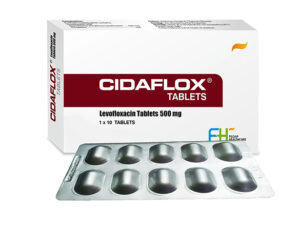
CIDAFLOX® TABLETS
Levofloxacin Tablets 500 mg
DRUG DESCRIPTION
CIDAFLOX® is a synthetic broad-spectrum quinolone antibacterial agent for oral administration.
INDICATIONS
To reduce the development of drug-resistant bacteria and maintain the effectiveness of CIDAFLOX® and other antibacterial drugs, CIDAFLOX® should be used only to treat or prevent infections that are proven or strongly suspected to be caused by susceptible bacteria. When culture and susceptibility information are available, they should be considered in selecting or modifying antibacterial therapy. In the absence of such data, local epidemiology and susceptibility patterns may contribute to the empiric selection of therapy.
CIDAFLOX® Tablets are indicated for the treatment of adults ( ≥ 18 years of age) with mild, moderate, and severe infections caused by susceptible isolates of the designated microorganisms in the conditions listed:
-
Nosocomial Pneumonia
-
Community-Acquired Pneumonia
-
Acute Bacterial Sinusitis
-
Acute Bacterial Exacerbation of Chronic Bronchitis (AECB)
-
Complicated Skin and Skin Structure Infections
-
Uncomplicated Skin and Skin Structure Infections
-
Chronic Bacterial Prostatitis
-
Complicated Urinary Tract Infections: 5-day Treatment Regimen
-
Complicated Urinary Tract Infections: 10-day Treatment Regimen
-
Acute Pyelonephritis: 5 or 10-day Treatment Regimen
-
Uncomplicated Urinary Tract Infections
-
Inhalational Anthrax (Post-Exposure)
-
Plague
DOSAGE AND ADMINISTRATION:
Dosage in Adult Patients with Normal Renal Function
The usual dose of CIDAFLOX® Tablets is 250 mg, 500 mg, or 750 mg administered orally every 24 hours.
These recommendations apply to patients with creatinine clearance ≥ 50 mL/min. For patients with creatinine clearance <50 mL/min, adjustments to the dosing regimen are required.
Drug Interaction With Chelation Agents: Antacids, Sucralfate, Metal Cations, Multivitamins
CIDAFLOX® Tablets should be administered at least two hours before or two hours after antacids containing magnesium, aluminum, as well as sucralfate, metal cations such as iron, and multivitamin preparations with zinc or didanosine chewable/buffered tablets or the pediatric powder for oral solution.
Administration Instructions
Food and CIDAFLOX® Tablets
CIDAFLOX® Tablets can be administered without regard to food
Hydration for Patients Receiving CIDAFLOX® Tablets
Adequate hydration of patients receiving CIDAFLOX® Tablets should be maintained to prevent the formation of highly concentrated urine. Crystalluria and cylindruria have been reported with quinolones.
CLINICAL PHARMACOLOGY
Mechanism of Action
Levofloxacin is a member of the fluoroquinolone class of antibacterial agents.
Regimen |
Cmax (mcg/mL) |
Tmax (h) |
AUC (mcg·h/mL) |
CL/F1 (mL/min) |
Vd/F2 (L) |
t½ (h) |
CLR (mL/min) |
Single dose |
|||||||
250 mg oral tablet3 |
2.8 ± 0.4 |
1.6 ± 1.0 |
27.2 ± 3.9 |
156 ± 20 |
ND |
7.3 ± 0.9 |
142 ± 21 |
500 mg oral tablet3* |
5.1 ± 0.8 |
1.3 ± 0.6 |
47.9 ± 6.8 |
178 ± 28 |
ND |
6.3 ± 0.6 |
103 ± 30 |
500 mg oral solution12 |
5.8 ± 1.8 |
0.8 ± 0.7 |
47.8 ± 10.8 |
183 ± 40 |
112 ± 37.2 |
7.0 ± 1.4 |
ND |
500 mg IV3 |
6.2 ± 1.0 |
1.0 ± 0.1 |
48.3 ± 5.4 |
175 ± 20 |
90 ± 11 |
6.4 ± 0.7 |
112 ± 25 |
750 mg oral tablet5* |
9.3 ± 1.6 |
1.6 ± 0.8 |
101 ± 20 |
129 ± 24 |
83 ± 17 |
7.5 ± 0.9 |
ND |
750 mg IV5 |
11.5 ± 4.04 |
ND |
110 ± 40 |
126 ± 39 |
75 ± 13 |
7.5 ± 1.6 |
ND |
Multiple dose |
|||||||
500 mg every 24h oral tablet3 |
5.7 ± 1.4 |
1.1 ± 0.4 |
47.5 ± 6.7 |
175 ± 25 |
102 ± 22 |
7.6 ± 1.6 |
116 ± 31 |
500 mg every 24h IV3 |
6.4 ± 0.8 |
ND |
54.6 ± 11.1 |
158 ± 29 |
91 ± 12 |
7.0 ± 0.8 |
99 ± 28 |
500 mg or 250 mg every 24h IV, patients with bacterial infection6 |
8.7± 4.07 |
ND |
72.5 ± 51.27 |
154 ± 72 |
111 ± 58 |
ND |
ND |
750 mg every 24h oral tablet5 |
8.6 ± 1.9 |
1.4 ± 0.5 |
90.7 ± 17.6 |
143 ± 29 |
100 ± 16 |
8.8 ± 1.5 |
116 ± 28 |
750 mg every 24h IV5 |
12.1 ± 4.14 |
ND |
108 ± 34 |
126 ± 37 |
80 ± 27 |
7.9 ± 1.9 |
ND |
500 mg oral tablet single dose, effects of gender and age: |
|||||||
Male8 |
5.5 ± 1.1 |
1.2 ± 0.4 |
54.4 ± 18.9 |
166 ± 44 |
89 ± 13 |
7.5 ± 2.1 |
126 ± 38 |
Female9 |
7.0 ± 1.6 |
1.7 ± 0.5 |
67.7 ± 24.2 |
136 ± 44 |
62 ± 16 |
6.1 ± 0.8 |
106 ± 40 |
Young10 |
5.5 ± 1.0 |
1.5 ± 0.6 |
47.5 ± 9.8 |
182 ± 35 |
83 ± 18 |
6.0 ± 0.9 |
140 ± 33 |
Elderly11 |
7.0 ± 1.6 |
1.4 ± 0.5 |
74.7 ± 23.3 |
121 ± 33 |
67 ± 19 |
7.6 ± 2.0 |
91 ± 29 |
500 mg oral single dose tablet, patients with renal insufficiency: |
|||||||
CLCR 50–80 mL/min |
7.5 ± 1.8 |
1.5 ± 0.5 |
95.6 ± 11.8 |
88 ± 10 |
ND |
9.1 ± 0.9 |
57 ± 8 |
CLCR 20–49 mL/min |
7.1 ± 3.1 |
2.1 ± 1.3 |
182.1 ± 62.6 |
51 ± 19 |
ND |
27 ± 10 |
26 ± 13 |
CLCR <20 mL/min |
8.2 ± 2.6 |
1.1 ± 1.0 |
263.5 ± 72.5 |
33 ± 8 |
ND |
35 ± 5 |
13 ± 3 |
Hemodialysis |
5.7 ± 1.0 |
2.8 ± 2.2 |
ND |
ND |
ND |
76 ± 42 |
ND |
CAPD |
6.9 ± 2.3 |
1.4 ± 1.1 |
ND |
ND |
ND |
51 ± 24 |
ND |
1clearance/bioavailability2volume of distribution/bioavailability3healthy males 18–53 years of age460 min infusion for 250 mg and 500 mg doses, 90 min infusion for 750 mg dose5healthy male and female subjects 18–54 years of age6500 mg every 48h for patients with moderate renal impairment (CLCR 20–50 mL/min) and infections of the respiratory tract or skin7dose-normalized values (to 500 mg dose), estimated by population pharmacokinetic modeling8healthy males 22–75 years of age9healthy females 18–80 years of age10young healthy male and female subjects 18–36 years of age11healthy elderly male and female subjects 66–80 years of age12healthy males and females 19–55 years of age.* Absolute bioavailability; F=0.99 ± 0.08 from a 500 mg tablet and F=0.99 ± 0.06 from a 750 mg tablet; ND=not determined. |
|||||||
